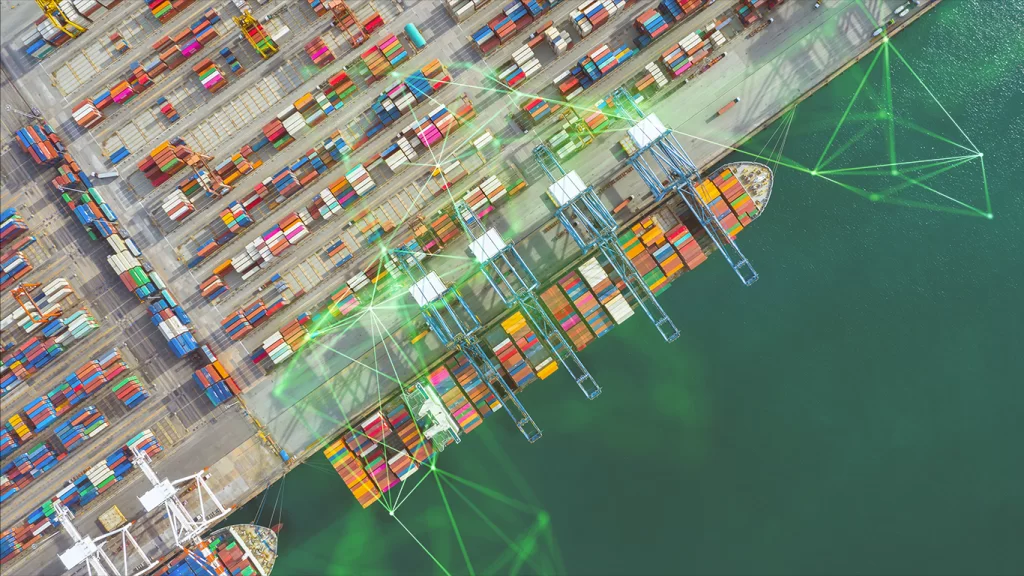
How Will AI Impact the Future of Supply Chain Management?
The idea of artificial intelligence (AI) has been around for a long time. Once considered an unattainable buzzword, it now represents a remarkable reality and underpins some of the most exciting technological advancements.
Machines can now pass the Turing Test and large language models (LLMs) are revolutionising text-based processes. AI has helped a paralysed man to walk again, is speeding up breast cancer diagnosis and can identify patterns that help with fraud detection in financial services.
With such rapid advancement and growing adoption of these technologies, AI is poised to reshape numerous sectors. As AI finally comes of age, we examine how it can help companies in supply chain management to automate repetitive tasks, reduce human error and gain valuable insights that help them make business decisions.
What is AI?
AI is a field of computer science that describes a system that mimics human intelligence. It does this through machine learning or deep learning, whereby it can understand something by examining large amounts of data and applying that to a problem or situation.
Using neural networks, an AI system can look at data and use algorithms to react in an autonomous way. The computer system adapts and acts according to what it has learned and inferred from data, without any explicit instructions.
At a basic level, all computers are artificially intelligent. They act at the simplest level of AI, reactive AI. They respond predictably to input, without learning. An example here would be the recommendation engines used by Amazon or Netflix. They make personalised suggestions about what to buy or watch based on our previous actions. They are always unique to us, so can be deemed intelligent, but they do not undertake autonomous actions without being programmed in advance to do so.
Further up in the AI scale is the ability to learn and react. Using observation and historical information, in conjunction with pre-programmed instructions, a system can make predictions and to act on them. Autonomous vehicles have this ability. They take historical data and combine it with observations from cameras and sensors to predict the actions of other road users and to act accordingly.
Self-driving cars are an example of limited memory AI. There are countless systems that make use of this level of AI, using common human traits, such as the ability to analyse information, take inferences from it and come to a conclusion. They can reason and problem solve, learning from prior experience. They include systems such as large language models (GPT), chatbots, voice-responsive smart technology and image recognition systems.
Beyond this, AI exists only as a concept. It’s generally agreed that there are two more levels of AI. The first describes a system that has additional emotional intelligence and can autonomously discern human needs, beliefs and emotions, to understand them and react accordingly.
The highest level of AI is the self-aware AI. This would be a system that is so like a human that it has self-awareness and can act independently at the same level as a human.
AI in the Supply Chain.
Recent research shows that “AI-enabled supply chains are over 67% more effective with reduced risk and lower overall costs”.
AI can be used in supply chains to improve efficiencies and customer service, save money and keep customers happy, all while learning, refining and streamlining supply chain processes.

Demand Forecasting and Stock Management.
One of the most promising potential uses of AI in the supply chain is to enhance demand forecasting. By analysing large volumes of data, companies can use AI to improve their demand forecasting accuracy. This could be historical information from inside a company or external data and experiences.
AI could use real-time data analysis and predictive analytics to make decisions about stock requirements. With optimised stock management through AI-powered demand forecasting, companies could reduce the number of stockouts, while anticipating demand surges and ensuring sufficient stock was available.
Imagine being able to accurately predict how many of which products customers will be buying next month or even next year. Getting these predictions right both saves and makes money, but it depends on a huge range of factors, like market trends, population, demographics, the weather, economic factors, politics, materials availability, and so much more. Only a sophisticated AI programme can analyse and model enough data to get this right.
Using AI, a distributor could predict the order in which items will enter and leave the warehouse and can use that information to store goods most appropriately. For example, fast moving goods that are accessed frequently can be placed closer to the packing and despatch areas, to minimise operative movements in the warehouse. Those that are predicted to be more slow moving can be placed in less accessible areas – on the higher racks, or furthest away from packing, for example.
With enhanced predictions, companies can free up storage space and reduce the amount of money tied up in stock. Using AI algorithms to predict demand could save millions of pounds for companies. This is particularly critical for any company operating with tight margins – like those in FMCG.
Inside the Warehouse.
Within the warehouse, AI-enabled systems can use computer vision to inspect goods. As good as – even perhaps better than – a human, these systems can spot manufacturing and assembly flaws. Employed on the production line itself, they can be used to pull faulty products before they reach the warehouse shelves.
For companies that manufacture and distribute expensive goods, AI can save money through limiting the number of returns made due to faulty goods. Or for those that are reliant on stringent safety procedures, having AI-enabled testing could prevent accidents and preserve reputations.
Using smart sensors and historical data, AI can also be used to predict when machinery and equipment might fail. This can ensure maintenance is scheduled correctly and pre-empt any problems. This has applications for all sorts of equipment used in warehouses, from vehicles like forklifts, to robotic arms, conveyors and other specialist materials handling equipment.
Autonomous mobile robots (AMRs) too, are sometimes powered by AI. Those powered by AI use sensors to avoid collisions with shelving, vehicles or workers, and use data to find the shortest or fastest routes around a facility.
Logistics and Transportation.
There is massive potential for AI to transform logistics and last-mile delivery.
Using AI, companies can improve load optimisation, using data that predicts order numbers and volumetrics. This would reduce the number of trips taken, limiting the number of vehicles and drivers required. Other AI-driven cost savings would come from predictive maintenance, ensuring vehicles are always roadworthy and maintained in good time.
Route planning already benefits from AI technology. Complex data algorithms can generate the most efficient routes by analysing traffic patterns, roadworks, weather conditions and delivery points. They can predict how traffic might be affected according to what day it is or what time it is.
For last-mile delivery, a number of companies have pioneered the use of drones, autonomous trucks and autonomous delivery vehicles. These vehicles can improve safety, reduce transportation costs and speed up deliveries.

Supply Chain Customer Service.
AI is used in customer service situations in the supply chain to facilitate and improve communications. Using large language models (LLMs) – the technology behind the likes of ChatGPT – chatbots can converse in natural language, make deductions, answer questions and solve customer problems.
Aside from the benefits companies could get in the provision of customer service, a LLM could be trained on the vast amount of internal company data, such as emails, meetings notes and other company documents. Here, the aim might be to answer internal queries or plug institutional knowledge gaps.
For example, an AI-powered LLM could reveal which customers are likely to pay late, explain why a certain supplier only delivers on Wednesdays or give details about how a particular issue was handled previously.
Hindrances to the Adoption of AI in the Supply Chain.
While the future looks bright for AI in the supply chain, it’s important to be aware of the hindrances and constraints involved.
Building and integrating an AI software system can be both costly and time-consuming for companies. Not only does it demand a skillset that many businesses lack, but it also entails navigating a steep learning curve due to the intricacies and complexities involved in these systems.
It is difficult to find people with the right data backgrounds and technical skills to develop and implement AI, as well as manage its dynamic abilities. Plus, for many companies, the costs of recruiting and employing additional people are prohibitive.
Beyond the initial implementation, a company must also consider if their chosen technologies require regular updates as well as how the company is placed to provide the ongoing data inputs needed.
Harnessing the Power of AI in Supply Chain Management.
Looking ahead, it is evident that AI will play an increasingly pivotal role in transforming supply chain management.
With its ability to automate tasks, reduce errors and unlock valuable insights, AI has the potential to revolutionise how supply chain businesses operate. The advantages it offers in optimising demand forecasting, enhancing warehouse operations, improving final-mile delivery and elevating customer service make for an exciting journey.
By harnessing the power of AI, companies can shift from being reactive to being proactive and unlock a future where supply chain management delivers greater efficiency and cost-effectiveness.
Geo2 uses intelligent algorithms to deliver dynamic routing, instantly calculating preferred routes against multiple constraints such as traffic conditions and delivery windows. For more information on how Geo2 can help play a part in the transformation of your supply chain management, contact us,or try for free today.






